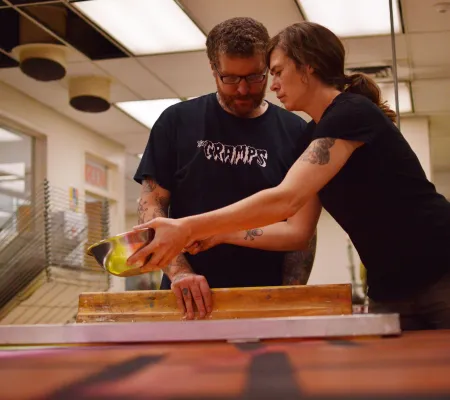Last month, the Guest Artist in Print Program (GAPP) invited Berlin-based artist duo Christian Gfeller and Anna Hellsgârd to The University of Texas at Austin for an artist residency. Over the course of ten days, the artists collaborated on the creation of a large-scale silk screen print project titled, Die Wand/Die Mauer.
The Guest Artist in Print Program (GAPP) is the visiting artist program of the Print Area within the Department of Art and Art History at UT Austin. GAPP seeks to expose the university community to a combination of emerging and established artists immersed in an expanded print practice.
This year, GAPP brought Gfeller and Hellsgârd, who started working together twenty-one years ago producing zines and artist books. They’ve been commissioned work for familiar brands like Converse, Sony and Vice. “We like to challenge ourselves workwise,” statesGfeller. “Pushing the boundaries keeps the work interesting, exciting. Research, experiment, risk taking; this is what being an artist is about.”
The duo’s work has grown to encompass large unique formats like wood, panels and canvas and they aren’t afraid to let the influence of “accidents” disrupt their process. “Accidents (smearing, offprints, misprints...) of the screen-printing process are one of the pivotal components of our work,” states Gfeller. “Functioning like this makes it harder to fit the art market expectations, but our freedom is more important than our comfort.”
Aaron Yuhas, a freshman art student at UT, assisted the Berlin duo during their residency. “[Gfeller and Hellsgârd] would say, ‘we are not chasing perfection’ and it was a profound statement,” Yuhas reflects. Screen printing usually requires perfection to create a crisp product, however Yuhas learned that Gfeller and Hellsgârd preferred to use the medium in an unconventional, abstract way. When asked why they didn’t paint free hand, Yuhas states, “they were adamant that you don’t get the same imperfections that you can with screen printing.”
Gfeller and Hellsgârd spend the majority of their time in their own print shop called Re:Surgo in Berlin. The project took its name from two German words for “wall,” one implying a structure built for separating an area and another for a permanent division in a building.
“Re:Surgo! stands for the idea of reinventing yourself,” states Gfeller. This notion is reflected in their open acceptance of “accidents” in their work and how, as artists, they have adopted an iterative, adaptive practice. Even though they are consistently working, they spoke about how they do still try and get out to meet friends and artists in the huge Berlin art scene and enjoy their individual hobbies of horse riding (Anna) and collecting vinyl (Christian).
Die Wand/Die Mauer was on view at the Visual Arts Center on October 27, 2016. Consisting of three free-standing billboards constructed out of screen printed plywood, each side of the of the freestanding “walls” were constructed to evoke the symbolic political meanings around walls in contemporary Germany and the United States. In contemporary Berlin, elections summon the papering of walls and buildings. During the Cold War, the Berlin Wall was erected by the German Democratic Republic, a Communist government, to divide Communist East Berlin from “fascist” West Berlin. One side of the wall made evident the presence of human contact and expression through graffiti and papering while propaganda, decoration and expression were heavily regulated on the other side. The final exhibition of Die Wand/Die Mauer recalls emergent issues of censorship and philosophical conflict in the contemporary United States.
After Gfeller and Hellsgrâd exhibited Die Wand/Die Mauer, the piece was deconstructed into smaller units and handed out to various students, alumni and visitors, much like the Berlin Wall itself upon its deconstruction in 1989. They are now working on documentation of the project, including collection of images of the smaller units with their new owners.


